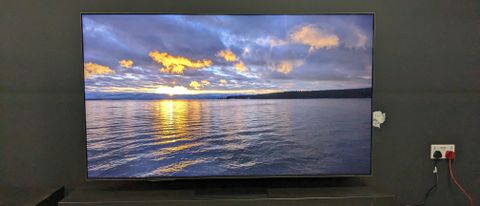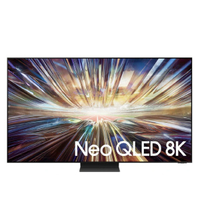TechRadar Verdict
The Samsung QN800D's incredible picture quality, led by effective 8K upscaling and outstanding levels of detail, proves that 8K TVs still deserve a place in the market. It also comes with a stack of gaming and smart TV features. Prices for 8K TVs continue to be extravagantly high, but the QN800D mostly justifies it.
Pros
- +
Exceptional detail and 8K upscaling
- +
Impressive gaming features and performance
- +
Sleek, slim design
Cons
- -
Pricey
- -
No Dolby Vision support
- -
Middling bass levels
Why you can trust TechRadar
Samsung QN800D review: Two minute review
The Samsung QN800D is the entry-level set in the company’s 8K Neo QLED range, offering 8K resolution at a slightly more affordable price than the flagship Samsung QN900D. It’s still a pricey TV, however, with the 65-inch model I tested currently selling for $3,499 / £3,499 / AU$4,799 – a higher price than most premium 4K TVs.
Samsung makes some of the best TVs and consistently flies the 8K flag as other brands move away from the technology. Based on the performance of the QN800D, it may be justified to fly that flag.
The QN800D’s picture quality is nothing short of impressive, mainly due to the exceptional 8K AI upscaling and Real Depth Enhancer Pro features of the TV’s NQ8 AI Gen2 Processor. These add incredible depth and refined detail to any textures, and the picture also has rich contrast and impressive black levels for a mini-LED TV. There is some minor backlight blooming and reflections can occur in harsh lighting conditions, but those are the only drawbacks of an otherwise phenomenal picture.
Gaming features are plentiful with the QN800D, with its four HDMI 2.1 ports kitted out with all the bells and whistles we look for in the best gaming TVs. The QN800D supports 4K up to 165Hz,8K up to 60Hz, VRR including AMD FreeSync Premium Pro and comes with Samsung’s useful Gaming Hub. Gaming performance is excellent, feeling smooth and seamless even in the most intense of FPS games, and with the TV’s 8K AI upscaling, graphically beautiful as well.
Sound quality is an area where the QN800D stumbles compared to the rest of its performance. A 4.2.2-channel speaker array provides exceptional tracking of on-screen action and dialogue is crisp and clear, but the QN800D’s lean bass means it can’t compete with some of the best TVs for sound such as the Sony A80L and Panasonic MZ2000. As such, it will be worth pairing the QN800D with one of the best soundbars to compliment its picture quality.
The QN800D uses Samsung’s ‘Infinity One’ design for a sleek, slim appearance with a near bezel-less look that allows the impeccable picture to be the star of the show. It also comes with Samsung’s One Connect Box to house all external source connections, making the QN800D perfect for wall mounting. It does come with a premium metal stand, but be warned, it can be a little fiddly to fit on.
There’s no getting around the fact that the QN800D is a premium-priced TV, with many flagship 4K models, including some of the best OLED TVs, selling for significantly less while still offering many of the same great features. There’s also a lack of 8K media to make full use of the QN800D’s high resolution. But the QN800D’s impressive 8K upscaling breathes extra life into every source it’s given, especially 4K movies with HDR. If you can stretch your budget for it you won’t be let down. I may have been skeptical about 8K TVs before, but the QN800D has made me a believer.
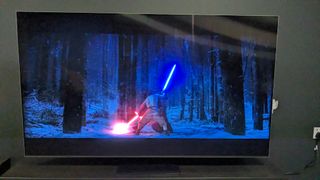
Samsung QN800D review: Prices & release date
- Release date: April 2024
- 65-inch: $3,499 / £3,499 / AU$4,799
- 75-inch: $4,499 / £4,499 / AU$6,499
- 85-inch: $5,999 / £6,999 / AU$8.999
The Samsung QN800D is the entry-level 8K Neo QLED model for 2024 and sits below the flagship Samsung QN900D. It is available in 65-, 75- and 85-inch sizes and was released in April 2024.
Since its release, we have seen some offers and reductions on the QN800D in its various sizes. The 65-inch model I tested has seen roughly $200 off, with as much as £500 off in the UK for the 85-inch model, though it still carries a high price tag across the board.
Samsung QN800D review: Specs
| Screen type: | 8K QLED with mini-LED |
| Refresh rate: | 165Hz (4K) / 60Hz (8K) |
| HDR support | HDR10+, HDR10, HLG |
| Audio support: | Dolby Atmos |
| Smart TV: | Samsung Tizen |
| HDMI inputs: | 4x HDMI 2.1 |
| Built-in tuner: | ATSC 3.0 (US) |
Samsung QN800D review: Benchmark results

Samsung QN800D review: Features
- NQ8 AI Gen2 Processor with 8K AI Upscaling Pro
- 4.2.2-channel speaker array
- One Connect Box
The Samsung QN800D uses the NQ8 AI Gen2 Processor, which boasts features such as 8K AI Upscaling Pro to upscale 4K images with up to 84% of the resolution of native 8K (according to Samsung). It also has Real Depth Enhancer Pro and Adaptive Picture, both of which use AI technology to analyze the picture and the surrounding environment to enhance images. The QN800D can display native 8K video, but there are no broadcast or home video 8K options outside of YouTube.
Like all Samsung TVs, the QN800D supports the HDR10+, HDR10 and HLG HDR formats, but not Dolby Vision.
For gaming, the QN800D is equipped with four HDMI 2.1 ports that support up to 165Hz refresh rate at 4K, 60Hz at 8K, VRR (including AMD FreeSync Premium Pro), ALLM and HGiG. It also features Samsung’s Gaming Hub that locates everything gaming-related in one handy location, including cloud-based gaming apps from Xbox, Luna, Nvidia GeForce Now and more.
The QN800D comes with the One Connect Box Slim, which houses all connections and links to the TV with a One Connect cable. This design keeps cables tidy, especially for wall-mount installations. Along with its four HDMI 2.1 ports, connections include optical digital audio out, an ATSC 3.0 tuner (US-only) and aerial and satellite connections for the UK, and three USB ports including USB-C.
For audio, the QN800D has a built-in 4.2.2 channel speaker array with 70W of power and support for Dolby Atmos. It also supports AI features such as Adaptive Sound Pro and Active Voice Amplifier Pro, which analyze the scene and viewing environment to optimize sound. The QN800D supports Q Symphony, which combines the TV’s audio output with compatible Samsung soundbars when connected.
The QN800D uses Samsung’s own Tizen smart TV platform, which appears largely unchanged for 2024 except for a new ‘recommended for you’ section that recommends movies and TV shows based on your past viewing. There is also a new 'Recent' window that lets you easily jump back into a movie or TV show you were recently watching.
- Features score: 5 / 5
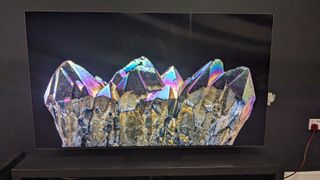
Samsung QN800D review: Picture quality
- Exceptional picture detail
- Effective 8K upscaling
- Minor reflections and backlight blooming
With he 65-inch QN800D’s picture presets in their default settings, peak brightness measured 1,045 nits measured on a 10% HDR window in Standard mode, and 1,126 nits in Filmmaker Mode.
Those results don't match up to the flagship Samsung QN900D, which clocked in at 1,979 nits on a 10% window in Filmmaker Mode when we tested it. It also isn’t as bright as the Samsung S95D QD-OLED, which gave a result of 1,868 nits peak brightness in Standard mode. But the QN800D did have excellent full-screen brightness results, measuring 626 and 528 nits in Standard and Filmmaker Mode respectively, and such high full-screen brightness makes it ideal for daytime viewing and sports.
When tested in our lab in varying lighting conditions, including harsh overhead lights, there were some mirror-like reflections on the QN800D’s screen, but they weren’t too distracting, and brighter images weren't an issue at all.
After cycling through picture presets, Filmmaker Mode was the most accurate. Standard will suit people looking for a brighter image, although textures don’t look as natural in that mode as in Filmmaker.
Upscaling on the QN800D is incredibly effective. Starting with broadcast TV viewing, in both standard (SD) and high-definition (HD), images looked crisp and clean. Even SD TV shows didn’t have the common fuzzy texture issue that regular LED TVs suffer from.
Moving onto a 4K stream of Star Wars: The Last Jedi on Disney Plus, the characters’ facial features were incredibly detailed, with Real Depth Enhancer Pro adding even greater refinement for a lifelike appearance. The throne room fight scene features lots of red tones and the QN800D displayed them in a bold, vibrant fashion, with lightsabers in particular taking on a shimmering brightness. When I measured the BT.2020 and UHDA-P3 color gamut coverage using Portrait Displays’ Calman software, it gave results of 69% and 94% respectively. Those numbers were lower than expected, but didn’t take away from the QN800D’s impressive color rendition.
Demo footage from the Spears & Munsil UHD Benchmark 4K Blu-ray disc revealed all the QN800D’s strengths. The outstanding level of detail demonstrated itself once again, with forest landscapes and sunsets on sea horizons looking incredibly realistic and animals appearing true to life. The 8K upscaling added an extra layer to these images that I’d seen so many times on 4K sets but importantly didn’t over-sharpen the textures for a fake-looking style.
Close-up studio images with fully black backgrounds demonstrated the QN800D’s superb contrast and black levels, with the bright objects well-balanced against the dark backgrounds. Some backlight blooming was visible, but it was minor. Scenes of a Ferris wheel and city skyscape at night also showcased the QN800D’s excellent local dimming, revealing only the slightest hint of backlight blooming once again.
Moving onto a 4K Blu-ray of The Batman, the QN800D displayed deep blacks and excellent shadow detail. In a scene where Batman walks down a gloomy hallway lit only by bright wall lamps, the QN800D kept the gloomy, grainy tone of the film while maintaining superb backlight control for spectacular contrast with only minor blooming. Once again, detail was impeccable with a close-up shot of Batman showing stubble I hadn’t noticed before on a 4K screen.
Motion handling on the QN800D was effective. Viewing the opening test flight sequence in Top Gun: Maverick, the long, panning shot that follows the Darkstar jet showed minimal judder even with motion controls turned off, although motion smoothing controls can be adjusted if you wish.
I decided to test the QN800D’s intelligence mode settings (its Adaptive Picture) which adjust brightness and color based on lighting conditions. In Optimized mode, I found that textures in Top Gun: Maverick were too sharp, taking away their natural look. An Eye Comfort mode adapts the color temperature based on the scene (cooler for bright, warmer for dark) to reduce eye strain, but unfortunately, this once again made textures too sharp. Thankfully these settings are switched off by default, allowing the more effective AI features to do their work.
Despite some backlight blooming and occasional screen reflections, the QN800D has an impressive picture overall, with outstanding detail, incredible 8K upscaling and spectacular color and contrast.
- Picture quality score: 5 / 5

Samsung QN800D review: Sound quality
- 4.2.2 channel speaker configuration
- OTS+ (Object Tracking Sound Plus)
- AI Adaptive Sound Pro
The QN800D has a 70W, 4.2.2 channel speaker system that supports Dolby Atmos. I found dialog to be clear across all sources, whether it was broadcast TV news or action-filled movie sequences. The TV’s Object Tracking Sound Plus feature is incredibly effective, with the sound closely following the action on screen. During the batmobile chase in The Batman, each screeching tire, explosion or crunch was naturally placed, and in Top Gun: Maverick, jets soaring in all directions were easy to follow.
Bass on the QN800D was solid enough, though it sounded thinner than the surround effects and dialog. Compared with other sets, there were only two sound presets: Standard and Amplify. Amplify provided the most accurate sound profile and was the mode I used for testing. In some instances, Atmos reproduction wasn’t the most effective, with the rain in the batmobile chase scene from The Batman being barely noticeable. In Top Gun: Maverick, however, there was a sense of spaciousness during any flight sequences.
The QN800D’s Adaptive Sound mode was more trebly and surround-focused, sacrificing the already lean bass. Adaptive Voice Pro as expected prioritized speech above all else and although effective in some scenarios, it wasn’t the best for movies.
Sound on the QN800D will be perfectly fine for most and is impressive in some areas, but this TV could benefit from one of the best Dolby Atmos soundbars to complement its fantastic picture quality.
- Sound quality score: 4 / 5

Samsung QN800D review: Design
- Slim One Connect Box
- Infinity slim design
- Fiddly stand installation
The QN800D has a premium ‘Infinity One’ design, with a solid, silver, metal frame and a trim bezel that allows the picture to become the main focus without any borders. It also measures a razor-thin 0.7 inches (17.2mm) without its stand.
An external One Connect Box houses all inputs, with a single cable connecting to the QN800D. It's a good design that keeps cables from sources tidy and is especially useful for people looking to wall-mount.
The QN800D also comes with a weighty, black metal stand that feels suitably sturdy and gives the TV a floating appearance when viewed front on. However, it’s worth noting that the stand was very fiddly to install, with me and a colleague needing to hold the stand in place while trying to line up and tighten the screws. Make sure you have another person with you when installing this TV.
Samsung’s SolarCell remote draws power from surrounding light and can also be charged using USB-C, making it significantly more eco-friendly than remotes with disposable batteries. Although on the minimal side, with settings, volume and app shortcut buttons for Netflix, Disney Plus and Prime Video making up the majority of buttons, it should suit most people.
- Design score: 4.5 / 5

Samsung QN800D review: Smart TV & menus
- Tizen smart TV platform
- Different portals for Gaming, Daily and more
- Customization options
The QN800D uses Samsung’s Tizen system as a smart TV platform. Although its overall design remains largely unchanged from 2023, there have been updates for 2024.
The home menu is now split into three categories: For You, which bases recommendations on apps and viewing history; Live, showing live TV; and Apps, which displays your installed apps. Navigation is easy enough across any of these menus, but For You is likely to be the most used.
There are also several ‘portals’ that can be accessed, with each housing a different category. Daily+ aims to be a day-to-day portal, encompassing apps such as Samsung Health, workout tracking and a video calling app. There is also Ambient, for displaying artworks and images, and Gaming Hub for everything gaming.
There are plenty of picture settings to play with for those who like to tweak and experiment and these are all easily accessible, allowing for high levels of customization. A fair amount of sound settings are provided as well, but as stated above, Standard and Amplify are the only sound presets.
- Smart TV & menus score: 4 / 5
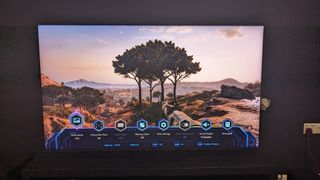
Samsung QN800D review: Gaming
- Four HDMI 2.1 ports
- Gaming Hub
- Low 9.8ms input lag
The QN800D is equipped with all the gaming features you would need, including 4K 165Hz and 8K 60Hz refresh rate, VRR with AMD FreeSync Premium Pro, and ALLM across all four HDMI 2.1 ports. The Gaming Hub portal houses everything gaming in one handy location, including links to popular live Twitch streams and cloud-based gaming apps including Xbox, Luna, Nvidia GeForce Now and more.
With Battlefield V on Xbox Series X, the gameplay felt incredibly smooth and free of any screen judder or tearing, and switching between targets in a vast landscape on a desert mission was seamless and easy. This is probably due in part to the QN800D’s ultra-low input lag, which I measured at 9.8ms using the Leo Bodnar HDMI 4K input lag tester – a number that rivals many of the best 120Hz TVs.
Graphically, the QN800D is extremely impressive. Using the same phenomenal 8K upscaling it does for movies, every detail in Battlefield V was amplified – the large desert landscapes took on a realistic look and the intricate details of the various weapons were more pronounced. The QN800D added depth to every aspect of the game, and I could adjust its game-related settings on the fly to enhance things even further by calling up the onscreen game menu.
- Gaming score: 5 / 5

Samsung QN800D review: Value
- Very pricey compared to 4K models
- Unique 8K features
- Limited 8K content
With the QN800D being an 8K TV (even a mid-range one by 8K standards) it unfortunately carries a high price tag. For the 65-inch model I tested, you’ll pay $3,499 / £3,499 / AU$4,799. To put that in perspective, you can buy the Samsung QN90D (Samsung’s upper mid-range 4K Neo QLED), which has many of the same gaming and smart features as the QN800D, in a 65-inch size for $2,699 / £2,399 / AU$3,995.
The QN800D does offer unique features compared to 4K models, most notably the 8K AI upscaling and the NQ8 Gen2 AI Processor. However, there are no real 8K sources outside of YouTube to make use of the QN800D’s native 8K display But if you can stretch your budget to make use of the 8K upscaling and processing chops the QN800D provides, I’d recommend it. Just keep in mind that you can buy a mid-range 4K OLED TV such as Samsung’s own S90C and one of the best Dolby Atmos soundbars for a good deal less.
- Value score: 3.5 / 5

Should I buy the Samsung QN800D?
| Attributes | Notes | Rating |
|---|---|---|
| Features | Superior processing, gaming and smart TV features | 5/5 |
| Picture quality | Incredible image detail and effective 8K upscaling | 5/5 |
| Sound quality | Excellent object-tracking and speech, but bass performance is average. | 4/5 |
| Design | Sleek and trim design with One Connect Box, but stand is a little cumbersome to install | 4.5/5 |
| Smart TV and menus | Tizen is all about customization, but home menu still a little cluttered. | 4.5/5 |
| Gaming | Stacked with gaming features and performs incredibly well | 5/5 |
| Value | despite Some fantastic, unique features but expensive in every size | 3.5/5 |
Buy it if...
You want incredible picture detail
The QN800D's 8K AI upscaling and real Depth Enhancer Pro boost picture detail to very realistic levels.
You want an accomplished gaming TV
With a full suite of gaming features across four HDMI 2.1 ports, a low input lag time and brilliant gaming graphics and performance, the QN800D is a superb gaming TV.
You want a physically good-looking TV
The QN800D has a sleek and razor-slim design with an almost invisible bezel and it comes with Samsung's One Connect Box to keep things tidy.
Don't buy it if...
You are on a budget
As an 8K TV, the QN800D is undoubtedly pricey and although now priced similarly to some flagship 4K TVs, it'll still exceed many budgets.
You need Dolby Vision support
Although its picture is impressive, like all Samsung TVs, the QN800D does not support Dolby Vision for movies or gaming.
You want an easy installation process
The QN800D's stand, while premium, did prove to be a bit of a pain to install, requiring two people to position and attach it to the TV itself.
Also consider...
| Header Cell - Column 0 | Samsung QN800D | Samsung QN900D | Samsung QN90D | Sony Bravia 9 |
|---|---|---|---|---|
| Price (65-inch) | $3,499 / £3,499 / AU$4,999 | $4,999 / £4,999 / AU$6,499 | $2,599 / £2,699 / AU$3,999 | $2,999 (US only at 65-inch) |
| Screen type | Mini-LED | Mini-LED | Mini-LED | Mini-LED |
| Refresh rate | 165Hz | 240Hz | 120Hz | 120Hz |
| HDR support | HDR10 / HLG / HDR10+ | HDR10 / HLG / HDR10+ | HDR10 / HLG / HDR10+ | HDR10 / HLG / Dolby Vision |
| Smart TV | Tizen | Tizen | Tizen | Google TV |
| HDMI ports | 4 x HDMI 2.1 | 4 x HDMI 2.1 | 4 x HDMI 2.1 | 2 x HDMI 2.1 |
Samsung QN800D 8K mini-LED TV
The flagship 8K TV in Samsung's 2024 TV lineup, the QN900D carries a lot of the same features as the QN800D but comes with a more advanced NQ8 Gen3 Ai Processor, better contrast, higher-quality audio and up to a 240Hz refresh rate. However, this all comes at a roughly $1,500 premium over the QN800D.
Samsung QN90D 4K mini-LED TV
The Samsung QN90D serves as the flagship 4K mini-LED in its 2024 lineup in the US (the QN95D is available in the UK and other regions). From what we've seen so far it's an excellent TV, with high brightness and contrast and good off-axis performance that'll make it ideal for daytime sport viewing. If it's anything like its predecessor, the QN90C, it's sure to be a hit.

Sony Bravia 9 4K mini-LED TV
The Sony Bravia 9 is Sony's flagship TV for 2024 and signals its decision to invest in mini-LED. It's an impressive TV, with excellent lighting control, bright highlights, and clever processing that delivers a remarkable mini-LED picture. However, the Bravia 9 carries quite a high price for a flagship 4K TV and is just shy of the QN800D's price.

How I tested the Samsung QN800D
- Tested in lab with varying light conditions
- Tested using a variety of SDR and HDR sources
- Measurements made using Portrait Displays' Calman software
I tested the Samsung QN800D in our lab, which allows me to view in conditions including harsh overhead lighting, dimmed lighting, and pitch black to test a TV's handling of reflections and the effectiveness of its backlight.
After an initial run-in period with some casual viewing to determine the most accurate picture mode, I then tested the QN800D using standard and high-definition broadcast TV, 4K Blu-ray, and 4K streaming apps such as Disney Plus and Prime Video, using reference scenes from TV shows and movies that I regularly use fo testing.
To test the QN800D's picture, I looked at contrast, color, brightness, backlight control, and motion. I also evaluated its sound quality, checking for object placement, speech clarity, bass levels and virtual surround sound delivery.
For objective testing, I used specialized equipment including a test pattern generator, colorimeter and Portrait Displays' Calman calibration software. I tested the QN800D (like all TVs) for SDR and HDR brightness, grayscale and color accuracy, and color gamut coverage.
For gaming performance, I used an Xbox Series X to test gaming features, graphics and overall quality. I also measured the QN800D's input lag using the Leo Bodnar HDMI 4K Input lag tester.
For a more detailed breakdown, check how we test TVs at TechRadar at the link.
- First reviewed: June 12, 2024
- Read TechRadar's reviews guarantee

James is the TV Hardware Staff Writer at TechRadar. Before joining the team, he worked at a major UK based AV retailer selling TV and audio equipment, where he was either telling customers the difference between OLED and QLED or being wowed by watching a PS5 run on the LG 65G2. When not writing about the latest TV tech, James can be found gaming, reading, watching rugby or coming up with another idea for a novel.

Two of the best VR games ever just launched, and you need to play them – my favorite Meta Quest 3 games and apps for October 2024
How to watch Real Madrid vs Barcelona live stream: El Clasico 2024 for free

Chinese rival to Intel and AMD vows to close performance gap with trio of CPUs nicknamed Three Musketeers
